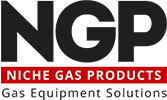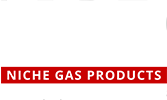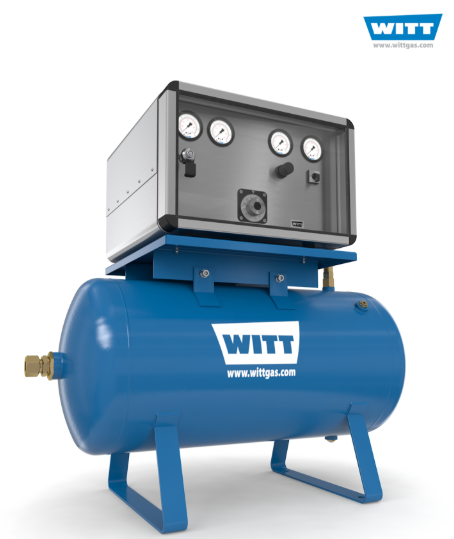Laser cutting and laser welding
Laser technology is often used as a thermal process in industrial metalworking. The word “Laser” stands for ‘Light Amplification by Stimulated Emission of Radiation’. Lasers can cut or weld various materials in various thicknesses precisely and cleanly.
Gases play an important role in the use of laser processes: As auxiliary materials, they are needed at different points in the process. Since gas mixtures are often used, gas mixers are usually used in conjunction with laser cutting systems and laser welding systems. The quality of the gas mixers or gas mixtures is of central importance for laser cutting and laser welding.
Operating gases and working gases in laser cutting and laser welding
Essentially, gases in laser technology can be divided into operating gases (resonator gases) and working gases (assist gases, and beam pathway purge gases): If it is a CO2 laser, gas is needed to operate the laser. This laser gas or resonator gas must be present in the resonator chamber of the laser. The assist gases serve multiple purposes; debris removal, oxidation prevention, addition of exothermic energy (adding to cutting speed), shielding, cooling, all depending on the exact nature of the job, and the chosen gas/mixture. Beam Pathway purge gases remove contamination from the beam line.
Gas mixtures are often used both for operating gases and for working gases. In many cases, these gas mixtures are produced by gas mixers. The quality of the gas mixtures, the purity and consistency of the mixture have a direct influence on the process quality both for the resonator gas and for the cutting gases and protective atmospheres. Even small deviations in the gas mixture can have a negative effect on the laser process and cause malfunctions. High-quality gas mixers from WITT provide the high gas mixture qualities required for laser cutting systems and laser welding applications.
Typical gases in connection with lasers are argon (Ar), oxygen (O2), carbon dioxide (CO2), nitrogen (N2) or hydrogen (H2). Common gas mixtures are for example argon and helium, argon and oxygen or argon and hydrogen.
Gas mixers for the production of laser gases
One of the most frequently used laser types in laser cutting machines for metal processing is the CO2 laser. CO2, nitrogen and helium are mixed to produce the required gas mixture. A special light beam (arc) is generated in the resonator chamber of the laser source by the action of electrical energy and the gas discharge of the CO2. Nitrogen supports energy transfer and the added helium improves heat dissipation. Not only the exact composition, but also a high purity of the gases is required.
The proven WITT gas mixers are connected upstream of the laser.
Laser cutting and cutting gases
Laser cutting offers some advantages compared to other thermal cutting processes:
- high precision
- high cutting speeds
- low heat input
- low component distortion.
There are laser cutting systems for three types of laser cutting: Flame cutting, fusion cutting and sublimation cutting. Flame cutting is usually performed with pure oxygen. If flame cutting is not suitable, nitrogen is often used for cutting. Argon is also used as an alternative. In practice, gas mixtures are often used instead of single gases. Depending on the type of material and thickness, different mixtures are required, which makes the use of flexible gas mixers particularly advantageous.
Gas mixers for the production of protective gas for the laser process
In order to guarantee a high-quality laser cutting process, a good protective gas mixture is necessary. It protects the material cut by the laser from negative influences from the ambient air, prevents corrosion or overheating, for example, and thus ensures a clean cut.
The laser optics are supplied with the gas mixture via a nozzle system in order to flush emissions and residues such as slag or melt out of the cutting gap. This blows away the debris, being the material removed or melted in the laser cutting process.
Nitrogen and oxygen are usually used for the protective gas mixture. In this case, the nitrogen has the function of cooling the surroundings of the laser beam, and oxygen promotes the stability of the arc. However, components of the shielding gas can also be argon or helium. WITT gas mixers reliably produce this required shielding gas and have been used in this sector for many years.
Laser welding and welding shielding gases
Laser welding offers numerous positive characteristics:
- Highly concentrated heat input
- high welding speed
- narrow heat-affected zone
- low distortion of the component.
As with laser cutting machines, the shielding gas also has several functions in laser welding:
- Protection of the material against oxidation
- Continuous removal of the plasma cloud above the workpiece.
The basis of the most common shielding gas mixtures is usually argon. The welding process can be influenced by adding different proportions of CO2, oxygen, helium, nitrogen or hydrogen. Gas mixers from WITT reliably supply the required gas mixtures of the highest quality.
WITT gas mixers are available for every power range of laser technology
Depending on the requirements of the process, different gas mixers are available for two or more gases. If, for example, laser cutting systems or laser welding equipment are used in continuous operation and for a high material thickness, gas mixers with a high flow capacity and a high quantity of mixed gases are the best choice. WITT offers customer-specific solutions that are tailored to the specific applications.






